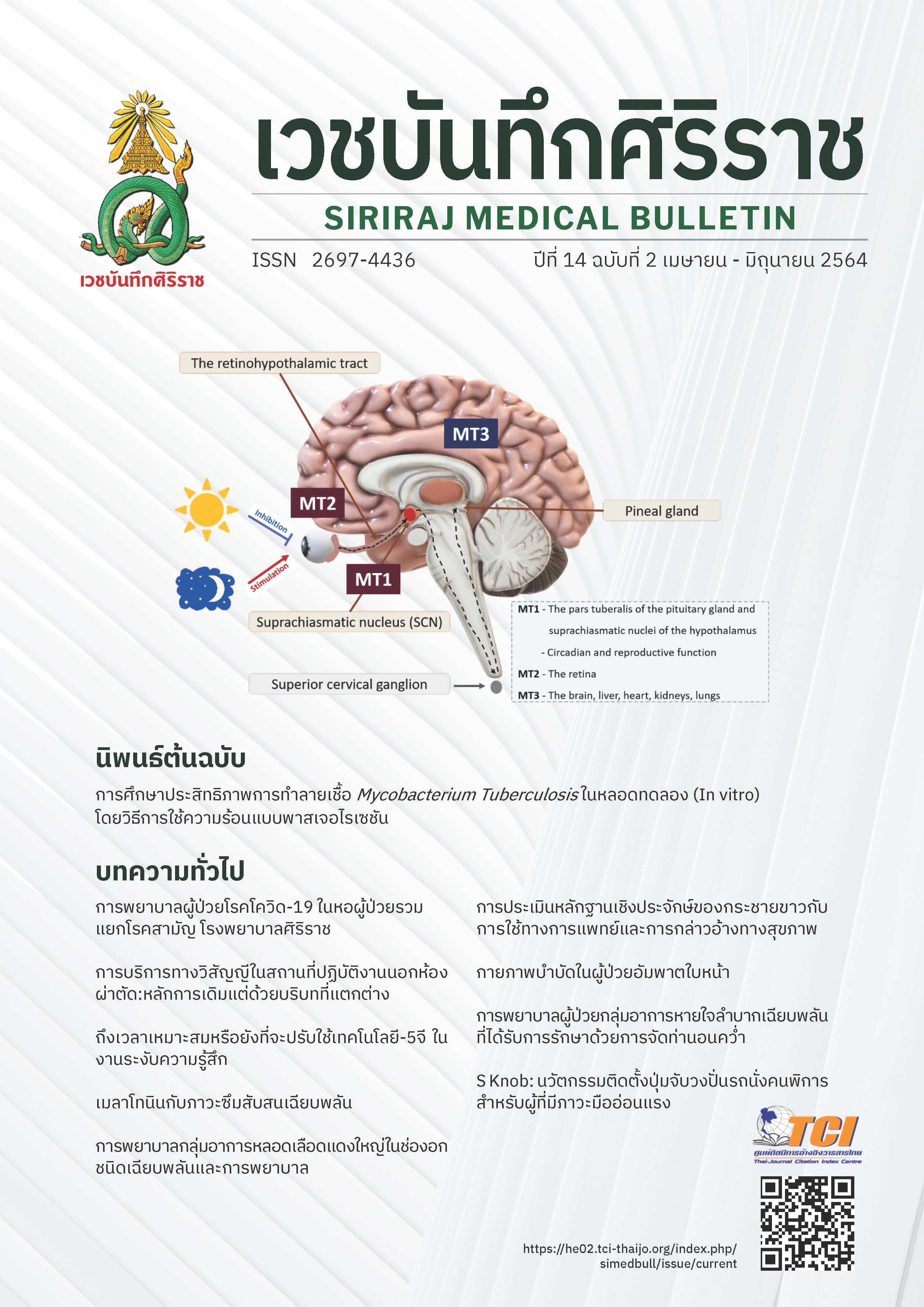Nursing the Patients with Acute Respiratory Distress Syndrome in the Prone Position
Main Article Content
Abstract
Acute respiratory distress syndrome (ARDS) is a critical and serious condition in respiratory system. ARDS causes lung injury which leads to hypoxia and high risk of death, especially if it is lack of appropriate treatment and immediate responses. This article aims to present prone position treatment on the ARDS patients, and holistic nursing guideline for the ARDS patients, and patients’ family. Prone position is a non-invasive treatment which can improve oxygenation due to increased blood flow in effective area of lungs. It can reduce the amount of atelectasis regions in lungs, and increase lung expansion. The guideline consists of 3 periods of nursing in the prone position; 1) pre-prone position period 2) during prone position period and 3) post- prone position turning period. Nurses are important as team members who provide the appropriate care for the patients. Nurses can improve safety and prevent complications of prone position treatment, and decrease the death rate in ARDS patients.
Article Details
References
Mittermaiera M, Pickerodtc P, Kurtha F, Bosquillon L, Uhriga A, Garciaa C, et al. Evaluation of PEEP and prone positioning in early COVID-19 ARDS. EClinicalMedicine.2020; 28(100579) [Internet]. 2020 [cited 2020 December 5]; Available from https://doi.org/10.1016/j.eclinm.2020.100579.
Zhou F, Yu T, Du R, Fan G, Liu Y, Liu Z, Xiang J, et al. Clinical course and risk factors for mortality of adult inpatients with COVID-19 in Wuhan, China: a retrospective cohort study. Lancet 2020; 395: 1054–62
Maca J, Ondrˇej J, Holub M, Sklienka P, Bursˇa F, Burda M, et al.Past and Present ARDS Mortality Rates: A Systematic. Review Respiratory Care. 2017; 62(1):113–22.
Koh Y. Update in acute respiratory distress syndrome. Journal of Intensive Care 2014; 2(2): 3-6.
Papazian L, Aubron C, Brochard L, Chiche D, Combes A, Dreyfuss D, et al. Formal guidelines: management of acute respiratory distress syndrome Ann. Intensive Care.2019; 9(69) [Internet]. 2019 [cited 2020 April 15]; Available from https://doi.org/10.1186/s13613-019-0540-9
Vito F, Aikaterini V, Shirin G, Umberto S, Arthur S, Haibo Z. Acute respiratory distress syndrome: new definition, current and future therapeutic options. Journal of Thoracic Disease 2013; 5(3):326-34.
Petrucci N, Iacovelli W. Lung protective ventilation strategy for the acute respiratory distress syndrome. The Cochrane database of systematic reviews 2007. The Cochrane database of systematic reviews 2007; (3):Cd003844[Internet]. 2013 [cited 2020 April 10]; Available from https://doi:10.1002/14651858.CD003844.pub4
Sottile P, Kiser T, Burnham E, Ho M, Allen R, Vandivier W, et al. An Observational Study of the Efficacy of Cisatracurium Compared with Vecuronium in Patients with or at Risk for Acute Respiratory Distress Syndrome. Am J Respir Crit Care Med. 2018; 197(7); 897–904.
Oliveira VM, Weschenfelder M, Deponti G, Condessa R, Henrique S, Maurello P, et al. Good practices for prone positioning at the bedside: Construction of a care protocol. Rev assoc med Bras. 2016; 62(3):287-93.
Guérin C, Reignier J, Richard J, Beuret P, Gacouin A, Boulain T, et al. Prone Positioning in Severe Acute Respiratory Distress Syndrome. The newengland journal of medicine. 2013; 368(23): 2159-68.
Gattinoni L, Busana M, Giosa L, Macrì M, Quintel M. Prone Positioning in Acute Respiratory Distress Syndrome. Semin Respiratory Critical Care Med. 2019; 40: 94–100.
Piehl MA, Brown RS. Use of extreme position changes in acute respiratory failure. Critical Care Med 1976; 4(01): 13–14.
Ponseti E, Millán A, Chinchilla D. Analysis of complications of prone position in acute respiratory distress syndrome: Quality standard, incidence and related factors. Enferm Intensiva. 2017; 28: 125-34.
Oliveira VM, Piekala DM, Deponti GN, Batista DC, Minossi SD, Chisté M, et al. Safe prone checklist: construction and implementation of a tool for performing the prone maneuver. Rev Bras Ter Intensiva. 2017; 29(2):131-41.
Ruste M, Bitker L, Yonis H, Riad Z, Durier AL, Lissonde F, et al. Hemodynamic effects of extended prone position sessions in ARDS. Ann. Intensive Care.2018; 8:120 [Internet]. 2018 [cited 2020 April 11]; Available from https://doi.org/10.1186/s13613-018-0464-9
Lucchini A, Bonetti I, Borrelli G, Calabrese N, Volpe S, Gariboldi R, et al. Enteral nutrition during prone positioning in mechanically ventilated patients. Assist Inferm Ric. 2017; 36(2):76-83.
Ndahimana D & Kim EK. Energy Requirements in Critically Ill Patients. Clin Nutr Res. 2018; 7(2):81-90.
Rouzé A, Jaillette E, Nseir S. Relationship between microaspiration of gastric contents and ventilator-associated pneumonia. Ann Transl Med 2018; 6(21):428. [Internet]. 2018 [cited 2020 April 11]; Available from https://doi: 10.21037/atm.2018.07.36


